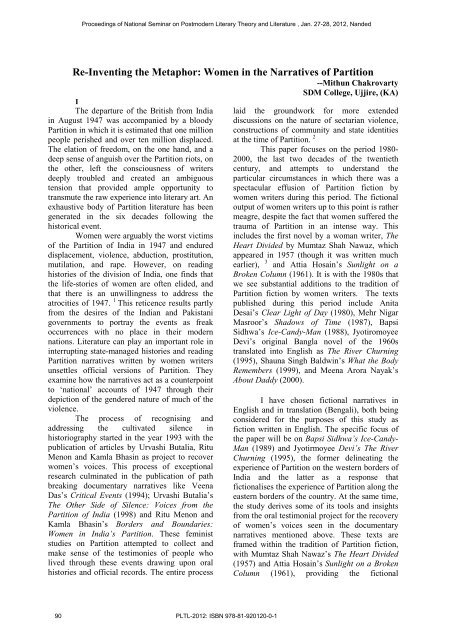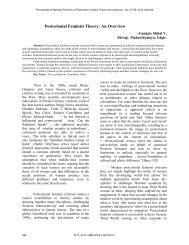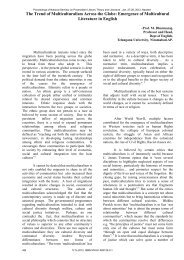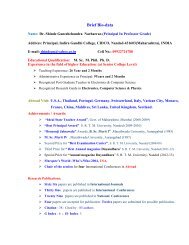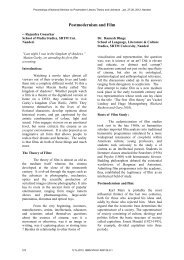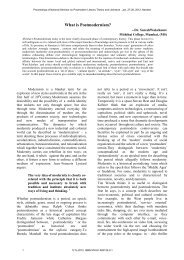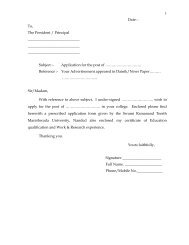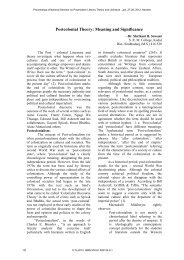Post-Structuralism: An Indian Preview - Igcollege.org
Post-Structuralism: An Indian Preview - Igcollege.org
Post-Structuralism: An Indian Preview - Igcollege.org
You also want an ePaper? Increase the reach of your titles
YUMPU automatically turns print PDFs into web optimized ePapers that Google loves.
Proceedings of National Seminar on <strong>Post</strong>modern Literary Theory and Literature , Jan. 27-28, 2012, Nanded<br />
Re-Inventing the Metaphor: Women in the Narratives of Partition<br />
--Mithun Chakrovarty<br />
SDM College, Ujjire, (KA)<br />
I<br />
The departure of the British from India<br />
in August 1947 was accompanied by a bloody<br />
Partition in which it is estimated that one million<br />
people perished and over ten million displaced.<br />
The elation of freedom, on the one hand, and a<br />
deep sense of anguish over the Partition riots, on<br />
the other, left the consciousness of writers<br />
deeply troubled and created an ambiguous<br />
tension that provided ample opportunity to<br />
transmute the raw experience into literary art. <strong>An</strong><br />
exhaustive body of Partition literature has been<br />
generated in the six decades following the<br />
historical event.<br />
Women were arguably the worst victims<br />
of the Partition of India in 1947 and endured<br />
displacement, violence, abduction, prostitution,<br />
mutilation, and rape. However, on reading<br />
histories of the division of India, one finds that<br />
the life-stories of women are often elided, and<br />
that there is an unwillingness to address the<br />
atrocities of 1947. 1 This reticence results partly<br />
from the desires of the <strong>Indian</strong> and Pakistani<br />
governments to portray the events as freak<br />
occurrences with no place in their modern<br />
nations. Literature can play an important role in<br />
interrupting state-managed histories and reading<br />
Partition narratives written by women writers<br />
unsettles official versions of Partition. They<br />
examine how the narratives act as a counterpoint<br />
to ‘national’ accounts of 1947 through their<br />
depiction of the gendered nature of much of the<br />
violence.<br />
The process of recognising and<br />
addressing the cultivated silence in<br />
historiography started in the year 1993 with the<br />
publication of articles by Urvashi Butalia, Ritu<br />
Menon and Kamla Bhasin as project to recover<br />
women’s voices. This process of exceptional<br />
research culminated in the publication of path<br />
breaking documentary narratives like Veena<br />
Das’s Critical Events (1994); Urvashi Butalia’s<br />
The Other Side of Silence: Voices from the<br />
Partition of India (1998) and Ritu Menon and<br />
Kamla Bhasin’s Borders and Boundaries:<br />
Women in India’s Partition. These feminist<br />
studies on Partition attempted to collect and<br />
make sense of the testimonies of people who<br />
lived through these events drawing upon oral<br />
histories and official records. The entire process<br />
laid the groundwork for more extended<br />
discussions on the nature of sectarian violence,<br />
constructions of community and state identities<br />
at the time of Partition. 2<br />
This paper focuses on the period 1980-<br />
2000, the last two decades of the twentieth<br />
century, and attempts to understand the<br />
particular circumstances in which there was a<br />
spectacular effusion of Partition fiction by<br />
women writers during this period. The fictional<br />
output of women writers up to this point is rather<br />
meagre, despite the fact that women suffered the<br />
trauma of Partition in an intense way. This<br />
includes the first novel by a woman writer, The<br />
Heart Divided by Mumtaz Shah Nawaz, which<br />
appeared in 1957 (though it was written much<br />
earlier), 3 and Attia Hosain’s Sunlight on a<br />
Broken Column (1961). It is with the 1980s that<br />
we see substantial additions to the tradition of<br />
Partition fiction by women writers. The texts<br />
published during this period include <strong>An</strong>ita<br />
Desai’s Clear Light of Day (1980), Mehr Nigar<br />
Masroor’s Shadows of Time (1987), Bapsi<br />
Sidhwa’s Ice-Candy-Man (1988), Jyotiromoyee<br />
Devi’s original Bangla novel of the 1960s<br />
translated into English as The River Churning<br />
(1995), Shauna Singh Baldwin’s What the Body<br />
Remembers (1999), and Meena Arora Nayak’s<br />
About Daddy (2000).<br />
I have chosen fictional narratives in<br />
English and in translation (Bengali), both being<br />
considered for the purposes of this study as<br />
fiction written in English. The specific focus of<br />
the paper will be on Bapsi Sidhwa’s Ice-Candy-<br />
Man (1989) and Jyotirmoyee Devi’s The River<br />
Churning (1995), the former delineating the<br />
experience of Partition on the western borders of<br />
India and the latter as a response that<br />
fictionalises the experience of Partition along the<br />
eastern borders of the country. At the same time,<br />
the study derives some of its tools and insights<br />
from the oral testimonial project for the recovery<br />
of women’s voices seen in the documentary<br />
narratives mentioned above. These texts are<br />
framed within the tradition of Partition fiction,<br />
with Mumtaz Shah Nawaz’s The Heart Divided<br />
(1957) and Attia Hosain’s Sunlight on a Broken<br />
Column (1961), providing the fictional<br />
90 PLTL-2012: ISBN 978-81-920120-0-1


